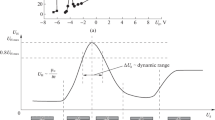Abstract
A compact model of a cross-shaped horizontal integrated Hall-effect sensor is presented in this paper. Compared to existing models, reliability is improved, especially to simulate systems in which biasing and measurement circuits are not independent. The Hall device model core, already published, is based on a network of six non-linear resistances and four Hall voltage sources, and includes only 11 physical parameters. In this paper, in order to improve model predictivity, four additional parameters have been added to take the offset issue into account. In addition, variations of parameters with temperature are also addressed. The model is implemented in Verilog-A and has been validated through experiments carried out on Hall devices designed in a CMOS 0.35μm technology. The parameters extraction procedure is detailed and the maximum error between simulations and experimental data is less than 1 % for a wide range of biasing currents and temperatures.














Similar content being viewed by others
References
Ramsden, E. (2006). Hall-effect sensors: Theory and applications. New York: Newnes.
Kammerer, J.-B., Hébrard, L., Frick, V., Poure, P., & Braun, F. (2003). Horizontal Hall effect sensor with high maximum absolute sensitivity. IEEE Sensors Journal, 3(6), 700–707.
Popovic, R., Randjelovic, Z., & Manic, D. (2001). Integrated Hall-effect magnetic sensors. Sensors and Actuators A, 91(2), 46–50.
van der Meer, J., Riedijk, F., de Jong, P., van Kampen, E., Meekel, M., & Huijsing, J. (2004). CMOS quad spinning-current Hall sensor system for compass application. In Proceedings of the 2004 IEEE Sensors, pp. 1434–1437.
Pascal, J., Hébrard, L., Frick, V., & Blondé, J. (2008). 3D Hall probe integrated in 0.35 μm CMOS technology for magnetic field pulses measurements. In Joint 6th IEEE NEWCAS and TAISA Conference (NEWCAS 2008), Montral (Canada), pp. 97–100, June 22–25, 2008.
Frick, V., Pascal, J., Hébrard, L., Blondé, J.-P., & Felblinger, J. (2007). CMOS integrated system for magnetic field monitoring and gradient measurement in MRI environment. In Proceedings of the 50th Midwest symposium on circuits and systems, MWCAS 2007, pp. 69–72.
Jovanovic, E., Pesic, T., & Pantic, D. (2004). 3D simulation of cross-shaped Hall sensor and its equivalent circuit model. In Proceedings of the 24th international conference on microelectronics, pp. 235–238.
Rossini, A., Borghetti, F., Malcovati, P., & Maloberti, F. (2005). Behavioral model of magnetic sensors for SPICE simulations. In Proceedings of the 12th IEEE international conference on electronic, circuits and systems (ICECS 2005), pp. 1–4.
Udo, A. (2004). Limits of offset cancellation by the principle of spinning current Hall probe. Proc. IEEE Sensor, 24, 1117–1120.
Schweda, J., & Riedling, K. (2002). A nonlinear simulation model of integrated Hall devices in CMOS silicon technology. In Proceedings of the 2002 IEEE international workshop on behavioral modeling and simulation, pp. 14–20.
Dimitropoulos, P., Drljaca, P., Popovic, R., & Chatzinikolaou, P. (2008). Horizontal HALL devices: A lumped-circuit model for EDA simulators. Sensors and Actuators A, 145–146, 161–175.
Madec, M., Kammerer, J. B., & Hébrard, L. (2010). An improved compact model of cross-shaped horizontal CMOS-integrated Hall-effect sensor. In 8th IEEE international northeast workshop on circuits and systems conference (NEWCAS 2010), Montreal (Canada), pp. 397–400, June 20–23, 2010.
Madec, M., Kammerer, J. B., Hébrard, L., & Lallement, C. (2011). An accurate compact model for CMOS cross-shaped Hall effect sensors. Sensors and Actuators A, 171, 69–78.
Blanchard, H., Iseli, D. R., & Popovic, R. S. (1997). Compensation of the temperature-dependent offset drift of a Hall sensor. Sensors and Actuators A, 60, 10–13.
Popovic, R. (2004). Hall-effect devices. Bristol: Institute of Physics.
Steiner, R., Maier, C., Mayer, M., Bellekom, S., & Baltes, H. (1999). Influence of mechanical stress on the offset voltage of Hall devices operated with spinning current method. Journal of Microelectromechanical Systems, 8(4), 466–472.
Munter, P. J. (1990). A low offset spinning-current Hall plate. Sensors and Actuators A, 22, 743–746.
Madec, M., Kammerer, J. B., Hébrard, L., & Lallement, C. (2011). Analysis of the efficiency of spinning-current techniques thru compact modeling. In Proceedings of IEEE sensors 2011, Limerick, Ireland, pp. 542–545, October 28–31, 2011.
Hull, R. (1999). Properties of crystalline silicon. London: INSPEC.
Sze, S. M. (2007). Physics of semiconductor devices. Hoboken, NJ: Wiley.
Cole, D. C., & Johnson, J. B. (1989). Accounting for incomplete ionization in modeling silicon based semiconductor devices. In Proceedings of the workshop on low temperature semiconductor electronics, Burlington, VT, USA, pp. 73–77.
Liu, C. M., Lou, K. H., & Kuo, J. B. (1993). 77 K versus 300 K operation: the quasi-saturation behavior of a DMOS device and its fully analytical model. IEEE Transactions on Electron Devices, 40(9), 1636–1644.
Shur, M. (1990). Physics of semiconductor devices. Upper Saddle River, NJ: Prentice Hall.
Kundert, K. (2004). The designer’s guide to Verilog-AMS. Boston: Kluwer.
Austrian Microsystems 0.35 μm CMOS C25 Process Parameters, 2007. www.ams.com.
Acknowledgments
The authors would like to thank Dr. Yann Leroy (InESS) for his valuable advices about COMSOL software; Pr. Maher Kayal, Dr. Jean-Michel Sallese and Dr. Marc Pastre (Ecole Polytechnique Fédérale de Lausanne, Switzerland) for valuable discussions about offset modeling; Mr. Yan Guehl (engineer student at the Ecole Nationale Supérieure de Physique de Strasbourg; France), who carried out the characterization measurements.
Author information
Authors and Affiliations
Corresponding author
Rights and permissions
About this article
Cite this article
Madec, M., Kammerer, JB., Hébrard, L. et al. An improved compact model for CMOS cross-shaped Hall-effect sensor including offset and temperature effects. Analog Integr Circ Sig Process 73, 719–730 (2012). https://doi.org/10.1007/s10470-012-9872-1
Received:
Revised:
Accepted:
Published:
Issue Date:
DOI: https://doi.org/10.1007/s10470-012-9872-1




